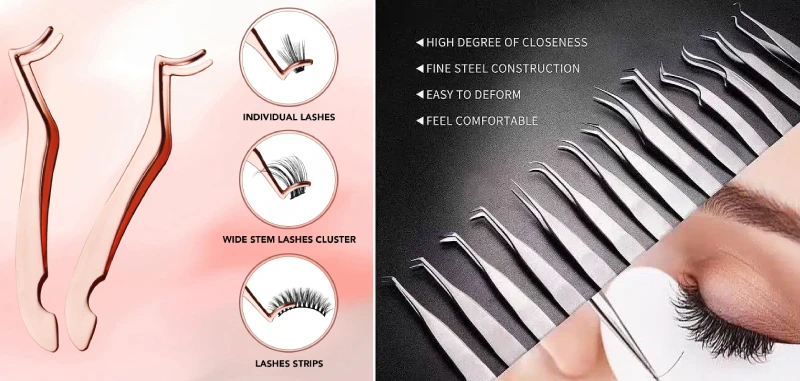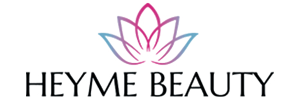![]()
In the beauty industry, not all tweezers are created equal. As a professional lash tweezer manufacturer, we’ve seen countless lash artists, salon owners, and even DIY enthusiasts struggle to choose between lash extension tweezers and lash cluster tweezers. At first glance, they may look similar, but in practice, the tools serve different purposes, require different skills, and are designed with distinct technical specifications.

This article will dive deep into both categories, combining insider knowledge, industry standards, customer feedback, and hands-on experience to help you make the best choice. Whether you’re a lash artist searching for precision tools or a beauty enthusiast looking to upgrade your DIY lash kit, you’ll find this comparison insightful, practical, and—most importantly—based on real-world expertise.
Lash Extension Tweezers: The Professional’s Trusted Companion
Lash extension tweezers are the backbone of professional lash artistry. They are designed to handle individual lash extensions with meticulous accuracy. The sharp tips, ergonomic handles, and finely calibrated tension make them a true extension of the artist’s hand.
From our manufacturing perspective, what sets lash extension tweezers apart is their engineering precision. Each pair must be carefully balanced to avoid unnecessary strain on the lash artist’s wrist and fingers. Industry standards, such as ISO 13485 for medical-grade tools, influence how we test durability, anti-corrosion resistance, and alignment.
We’ve had salon owners tell us things like:
“Switching to your titanium lash tweezers changed the game for my team. Less hand fatigue, more precision, and fewer dropped lashes—it’s worth every penny.”
Lash extension tweezers come in various shapes (I-shape, L-shape, S-shape, X-shape), each tailored for classic, hybrid, or volume lash techniques. For example, L-shape tweezers are favored for Russian Volume fans, while straight tweezers are ideal for isolation.
In short, lash extension tweezers are for professionals who want precision, efficiency, and consistency. They’re the tools you’ll find in every lash salon worldwide.
Lash Cluster Tweezers: The DIY-Friendly Tool
Unlike extension tweezers, lash cluster tweezers are designed with accessibility in mind. They are not meant for handling ultra-fine individual lashes but rather for gripping pre-made lash clusters or strips. This makes them ideal for beauty lovers who want a salon-style look at home without the complexity of professional extensions.
The biggest differentiator is safety design. Cluster tweezers often feature rounded or duller tips to reduce the risk of injury during self-application. Their lightweight build and angled tips make it easier for beginners to align clusters close to the lash line.
One customer review we received said:
“As a first-time DIY lash user, I was nervous. But your cluster tweezers felt safe, easy to handle, and gave me salon-quality lashes at home. I’ll never go back to strips.”
Cluster tweezers are also built with durability in mind, usually stainless steel that resists corrosion but without the extreme sharpness or tension needed in professional tweezers. They’re more forgiving, making them beginner-friendly.
For wholesale buyers, these tweezers are often best-sellers in the retail and e-commerce space because they appeal to a much larger consumer base—anyone who wants fuller lashes without visiting a salon.
Key Differences Between Lash Extension Tweezers and Lash Cluster Tweezers
When you line up the two tools side by side, the differences become clear.
| Feature | Lash Extension Tweezers | Lash Cluster Tweezers |
|---|---|---|
| Primary Use | Professional salon lash extensions | DIY lash clusters at home |
| Tip Design | Sharp, fine, precision-engineered | Rounded or angled, safety-focused |
| Material | Titanium or medical-grade stainless steel | Stainless steel (durable, but simpler) |
| Skill Level | Requires professional training | Beginner-friendly |
| Comfort | Ergonomically balanced for long sessions | Lightweight, easy grip |
| Market | Lash salons, professionals, wholesalers | Beauty retailers, DIY consumers |
| Standards | Must follow sterilization & hygiene protocols | Consumer-safe design focus |
In other words: lash extension tweezers = precision artistry, lash cluster tweezers = convenience at home.
Professional Standards and Safety Regulations
Working as a tweezer manufacturer means we are bound by industry regulations and safety standards. For lash extension tweezers, sterilization protocols are especially critical. The Centers for Disease Control and Prevention (CDC), as well as ISO standards, emphasize sterilization between clients to prevent cross-contamination. Professional tweezers must withstand autoclave sterilization or UV disinfection without warping.
Cluster tweezers, while used in more casual settings, are still manufactured under consumer safety guidelines. For example, we ensure that the dull tips pass cosmetic safety inspections to avoid accidental injuries during at-home applications.
This dual commitment—to professional hygiene and consumer safety—underscores the responsibility of manufacturers like us to create tools that are not just effective, but safe.
Feedback from Wholesalers and End Customers
As a manufacturer, we don’t just build tools—we listen. Over the years, feedback has shaped how we refine our tweezer designs.
- From wholesalers: “Your packaging and durability standards have helped us stand out in a crowded market. Clients know they’re getting professional-grade tools.”
- From lash artists: “We’ve tried cheaper tweezers, but the grip tension was inconsistent. Your tweezers save us time and reduce mistakes.”
- From DIY users: “I was afraid I’d poke myself, but the cluster tweezers felt safe and gave me the lashes I wanted in 10 minutes.”
This blend of professional and consumer feedback highlights that while the two categories serve different audiences, quality and trust remain universal expectations.
Which One Should You Choose?
Here’s the honest truth:
- If you’re a lash professional creating bespoke lash sets daily, lash extension tweezers are non-negotiable. They give you the precision and control required for advanced techniques.
- If you’re a DIY enthusiast or someone who wants quick, salon-style lashes at home, lash cluster tweezers are the safer, simpler option.
Both tools excel in their own fields. The key is not asking “which is better?” but rather “which is better for my needs?”
FAQs
1. Can lash extension tweezers be used for lash clusters?
Technically, yes—you can use lash extension tweezers to pick up and apply lash clusters. However, it’s not the most practical or safe option. Lash extension tweezers are engineered with sharp, ultra-fine tips for isolating natural lashes and handling extremely thin, lightweight lash fibers (often as fine as 0.07mm). When used on lash clusters, which are thicker, heavier, and pre-bonded fans, the tweezers may feel too sharp and even damage the lash clusters by splitting or fraying them.
From our experience as a manufacturer, we’ve also seen lash beginners accidentally poke or scratch themselves while attempting DIY cluster applications with sharp professional tweezers. For this reason, we recommend cluster tweezers for clusters—they have a safer tip design and offer a wider gripping surface, making cluster placement more controlled and beginner-friendly.
2. Are titanium tweezers worth the investment?
For professionals, the answer is a resounding yes. Titanium tweezers have several advantages that make them stand out compared to stainless steel alternatives:
- Feather-light design: Titanium is almost 40% lighter than stainless steel, which makes a huge difference during long lash sessions. Many lash artists report less hand fatigue and wrist strain when switching to titanium tools.
- Corrosion resistance: Unlike stainless steel, titanium tweezers are completely rust-proof. They can withstand constant sterilization in autoclaves or UV boxes without losing their structural integrity.
- Hypoallergenic: Titanium is naturally free from nickel, which means it won’t cause allergic reactions—important for lash artists working with sensitive clients.
- Durability: They are strong but springy, maintaining their grip tension for years with proper care.
While titanium tweezers do cost more upfront, they are a long-term investment for serious lash professionals. As one lash trainer told us: “Switching to titanium tweezers cut down my replacement costs and kept my staff more comfortable during peak seasons. Worth every cent.”
3. How do I clean and sterilize my tweezers?
Cleaning protocols depend on whether you’re working in a professional salon or using tweezers at home:
- For lash extension tweezers (professional use):
- After every client, tweezers should be cleaned with a professional adhesive remover or tweezer cleaner to dissolve lash glue residue.
- Once clean, they must be sterilized either in an autoclave (steam sterilization) or a UV disinfection box. This ensures that no bacteria, viruses, or cross-contamination occur between clients.
- Storing tweezers in a closed, sterile case between sessions is also recommended by hygiene guidelines.
- For lash cluster tweezers (DIY use):
- Since they are not used across multiple clients, a thorough wipe with 70% isopropyl alcohol is usually sufficient.
- Keep them in a clean pouch or case to avoid dust, dirt, or accidental bending of the tips.
🔑 Pro Tip: Never leave adhesive residue sitting on your tweezers. Over time, it can throw off the balance of the tool and reduce precision.
4. Do all lash artists need multiple tweezer types?
Yes—every professional lash artist should own multiple tweezer types to cover different lash extension techniques. Think of tweezers as “specialized tools” rather than one-size-fits-all.
- Straight tweezers (I-shape) → Best for isolating natural lashes.
- Curved tweezers (S-shape or F-shape) → Excellent for attaching classic extensions.
- L-shape tweezers → Perfect for creating and placing handmade Russian Volume fans.
- Round-tip tweezers → Safe for removing eye pads or tapes without poking the client.
Professional lash educators recommend at least 3–4 tweezers in a lash artist’s kit. As one wholesaler client told us: “Our students quickly realize one tweezer won’t get the job done. Having the right shape for the right technique improves speed and precision.”
5. Are cluster tweezers safe for beginners?
Absolutely. Cluster tweezers are specifically designed with safety and ease of use in mind. Unlike sharp professional tweezers, cluster tweezers typically have:
- Angled or flat tips for better grip on cluster fans.
- Rounded or dull edges to reduce the risk of poking your eyelid during DIY application.
- Lightweight construction so they’re easier to handle, even for people with no prior experience.
This makes them ideal for beauty enthusiasts who want to apply DIY cluster lashes at home without worrying about salon-level precision. In fact, many first-time users have told us: “I felt so confident using cluster tweezers. They made it impossible to mess up my lashes.”
6. What’s the biggest mistake when choosing lash tweezers?
One of the most common mistakes is ignoring comfort and grip tension. Many people focus only on price or style, forgetting that tweezers are tools used for hours at a time. Poorly balanced tweezers can cause:
- Hand fatigue and cramping during long sessions.
- Inconsistent grip, leading to dropped or misplaced lashes.
- Posture problems if the tweezers require awkward angles to work properly.
Another mistake is buying tweezers without considering your technique. For example, a lash artist specializing in Russian Volume will struggle with straight tweezers, while a DIY beginner may find professional-grade tweezers too sharp and intimidating.
Conclusion
At the end of the day, whether you choose lash extension tweezers or lash cluster tweezers depends on your goals. Our years of experience as a manufacturer taught us that no single tweezer fits all purposes. Instead, the right tool empowers the user—be it a seasoned lash artist crafting flawless extensions or a DIY beauty lover perfecting weekend lashes.
By considering safety, ergonomics, material quality, and professional standards, you’ll find the tweezers that don’t just get the job done, but make the process effortless.
